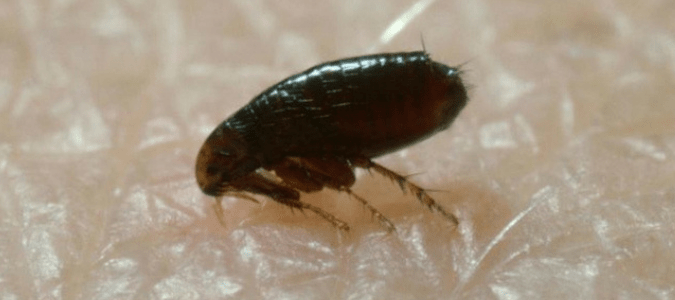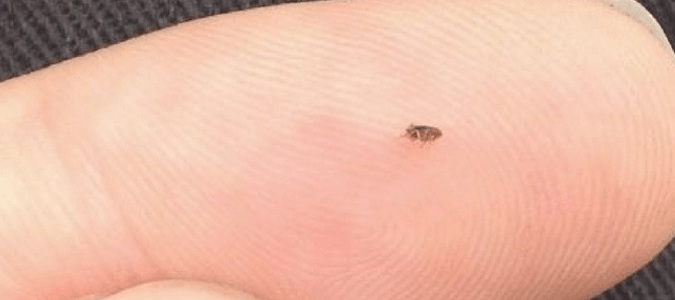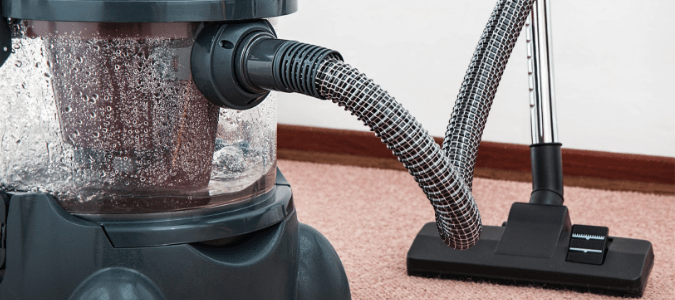Does One Flea Mean An Infestation?

It started with a scratch. At first, you didn’t think much of it, but your dog had been itching nonstop for a few weeks now. When you took a closer look at your pet’s fur, you noticed a small creature hop out of sight which seemed to confirm what you might have already suspected: a flea has been tormenting your beloved furry family member.
Soon after you conclude that you might have a flea in your home, you may wonder, “does one flea mean an infestation?”
While one flea may not seem like a big deal, these small bugs breed extremely quickly. So fast that if immediate action is not taken, an infestation is surely on the horizon.
In this post, we’ll talk more about flea behavior and activity and offer up some tips on what to do if your home is invaded by these tiny parasites.

Is One Flea A Problem?
Fleas are common household pests which prefer dog and cat blood, but can also feed on humans. Homes can become infested after just one of these high-flying creatures launches itself from somewhere in your yard onto your pet’s body, or even your pant leg, and hang on tight until you or your dog or cat come back inside. These insidious hitchhikers can feed within minutes of finding a host and can breed within 24 hours, laying up to 50 eggs a day in your home and yard. So, yes, one flea can—and often does—become a problem.
Flea eggs usually fall off your pet and land anywhere your pet spends time: carpets, furniture and in bedding. If your pet sleeps with you, fleas could end up on your bed as well. In only a few days, these eggs hatch. Adult fleas are about one-eighth of an inch in length, and are brown to black in color. While most fleas during peak season live for around three weeks, these parasites can survive on their hosts for over 100 days.
One adult flea can consume as much as 15 times its body weight daily. Flea bites can cause swelling and irritation on your pet’s skin, and may even lead to a bacterial infection and hair loss. To make matters worse, fleas can spread bacteria and viruses, and can serve as a host for tapeworms, meaning that a grooming pet can unknowingly swallow an infected flea, leading to an even more serious infection.
Once they have become established, fleas can be spread to raccoons and opossums that might frequent your property, who can then reinfest your yard after outdoor treatments, making controlling the population on your property even more difficult.
Once fleas have infested your home, you’ll need to be vigilant about treating your pet, home and yard and also implement a monitoring schedule to ensure these pests don’t come back.

How Many Fleas On A Dog Is Considered An Infestation?
Since just one bite can jumpstart a quickly-moving reproductive cycle, finding a flea on your dog or cat means that you probably already have a problem. Any pet can pick up the ubiquitous flea if they spend time outside, in kennels or around other animals. Even an indoor pet that rarely spends time in the great outdoors isn’t entirely immune from fleas. This is because the humidity inside our homes is often stable, meaning fleas can thrive inside any time of year after an unsuspecting host brings these pests indoors.
Fleas are not easily visible—especially when they’re living on our pet. However, if an infestation is heavy, you may be able to spot the fleas on your dog’s skin. Another sign you might have a flea problem is spotting small black or brown specks on or around your pet’s bedding. These specks resemble coffee grounds and are sometimes called “flea dirt”. This substance is flea feces, which turns a reddish color if wet.
While they are so small you are unlikely to notice them, flea eggs are oval-shaped and white and are about the same size as a salt crystal. For the most part, the most obvious sign of a flea infestation is noticing your pet scratching more than usual or spotting an irritated “hot spot” on its skin from flea bite dermatitis.
If you notice your dog or cat is miserable and you think fleas are the reason why, you’ll want to schedule an appointment with your veterinarian immediately. Your vet can diagnose the reason for excessive scratching and recommend effective products that will kill the fleas, both fully grown and in immature stages, on your dog or cat. Do keep in mind that homeowners with multiple pets should treat each animal separately, since fleas can move from one pet to another and some treatments for dogs can be dangerous if administered to cats.
Now that we have established the risk these parasites pose to your home and furry friends, let’s talk about when you are more likely to see them.

When Fleas Are The Worst: When Should I Be On The Lookout?
Fleas are the most active during late spring and summer, although homes can become infested any time of year. Warmer conditions favor larval development, which is why you tend to see increased numbers during these periods. In years that the weather is humid and rainy, flea populations tend to spike.
Protect your furry friends and your home during peak flea season by utilizing the suggested measures above or by seeking guidance from a trusted pest specialist.
How To Get Rid Of Fleas Naturally: What Can I Do?
If you’ve had a flea problem, chances are that you have asked yourself “How can I find out how to stop fleas from biting me and my pet?”, because flea infestations can go on for months if you try various home remedies. You may find claims online that cedar bedding, garlic, Brewer’s yeast, nematodes, vitamin B, ultrasonic devices and herbal collars can control fleas.
Sadly, there is little scientific proof that many of these DIY flea control methods or others you may have heard about actually work.
Many types of treatments only work within specific parts of a flea’s life cycle. For example, most insecticides are not particularly effective during the pupae stage. That means that follow-up is often required to ensure the reproductive cycle of this prolific pest is halted. In addition, effective flea treatment relies on treating the host, the home and the outdoor areas—so if one area stays infested, you may have to start all over again.
Since controlling a flea infestation can be complicated, most homeowners decide to call in the pros to take over. But what if you want to try to handle an infestation on your own? There are a few things you can do to reduce the number of fleas on your property.

Practice Good Housekeeping
The best way to keep fleas from multiplying in your home is to remove them from the environment. You can do this by vacuuming carpets, cushions, beds, chairs, furniture, along baseboards and floors daily. While this may seem tedious, vacuuming can reduce the flea larvae in your home by 30% and get rid of as much as 60% of flea eggs. Pay particular attention to bedding. Throw vacuum bags in your outdoor trash at least once every week so that you don’t risk a reinfestation.
While flea traps won’t solve a problem on their own, these devices can help in capturing mature fleas in common pet resting areas. Most attract these pests with a special type of light that mimics a host passing by, attracting fleas and then trapping on a sticky card.
In addition to vacuuming and trapping fleas, you’ll want to also wash anything your pet sleeps in or around every few weeks in soapy, hot water. Consider replacing bedding when faced with a severe infestation. Treat your carpets with steam, since high heat and soap can kill fleas in all four stages of their life cycle.
Keep Pets Indoors
As a temporary measure, reduce the amount of time pets spend indoors, as a precaution. Make sure dogs and cats let outside aren’t allowed under the house where other types of infested wildlife could be living. Don’t forget about smalller animals that could be carriers, too. Remove water and food sources for rodents on your property, including putting away bird feeders, emptying birdbaths, making sure trash containers are tightly closed and keeping pet bowls indoors until the infestation is brought under control.
Treat Your Pets
A bath can help with minor infestations, since soap remove some of these pests from your pet’s fur. Specially-designed metal combs can remove adult fleas from your dog or cat, especially when you focus on their face, ears, neck and tail. Insect growth regulators are low-impact alternatives to chemical treatments which may be recommended by your vet to target fleas and larvae. These treatments can come in the form of a spray, pill, dip, flea collar or injection.
Some botanical insecticides are now available that use citrus oil and pyrethrum to control adult fleas. Some cats and breeds of dogs are sensitive to citrus-based products, so use these treatments carefully and in accordance with product instructions and your vet’s oversight.
Treat Your Home
While these offer limited longer-term impact, some lower toxicity treatments, when used indoors, can temporarily help kill fleas. These products can be applied to pet bedding, carpeting and rugs and often contain linalool or limonene. Other products containing borates, methoprene and pyriproxyfen have been proven to be effective, if you pay close attention to where, when and how to apply these treatments.
Chem-Free Can Resolve Your Flea Problem
Fleas can survive long periods under a surprising range of conditions and require specialized treatment for removal. If you’re struggling with fleas in your home and want some relief without putting your family or the environment at risk, call on Chem-free. Our expert technicians can identify the source of your problem and suggest low-impact intervention methods to protect your family and pets from the hassle and discomfort of flea bites. Contact us by phone or online to schedule a service.

